All About Environmental Engineers
Job Description & Duties Research, design, plan, or perform engineering duties in the prevention, control, and remediation of environmental hazards using various engineering disciplines. Work may include waste treatment, site remediation, or pollution control technology.
Environmental Engineer Responsibilities
- Coordinate or manage environmental protection programs or projects, assigning or evaluating work.
- Obtain, update, or maintain plans, permits, or standard operating procedures.
- Write reports or articles for Web sites or newsletters related to environmental engineering issues.
- Develop site-specific health and safety protocols, such as spill contingency plans or methods for loading or transporting waste.
- Assess the existing or potential environmental impact of land use projects on air, water, or land.
- Develop proposed project objectives and targets and report to management on progress in attaining them.
Environmental Engineer Required Skills
Below is a list of the skills most Environmental Engineers say are important on the job.
Reading Comprehension: Understanding written sentences and paragraphs in work related documents.
Critical Thinking: Using logic and reasoning to identify the strengths and weaknesses of alternative solutions, conclusions or approaches to problems.
Active Listening: Giving full attention to what other people are saying, taking time to understand the points being made, asking questions as appropriate, and not interrupting at inappropriate times.
Active Learning: Understanding the implications of new information for both current and future problem-solving and decision-making.
Complex Problem Solving: Identifying complex problems and reviewing related information to develop and evaluate options and implement solutions.
Writing: Communicating effectively in writing as appropriate for the needs of the audience.
Other Environmental Engineer Job Titles
- Environmental Project Manager
- Water Resources Engineer
- Hazardous Waste Management Control Engineer
- Reservoir Engineer
- Environmental Coordinator
Is There Job Demand for Environmental Engineers?
In 2016, there was an estimated number of 53,800 jobs in the United States for Environmental Engineer. New jobs are being produced at a rate of 8.4% which is above the national average. The Bureau of Labor Statistics predicts 4,500 new jobs for Environmental Engineer by 2026. The BLS estimates 4,000 yearly job openings in this field.
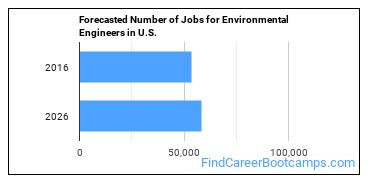
The states with the most job growth for Environmental Engineer are Colorado, Utah, and Nevada. Watch out if you plan on working in Maine, Alaska, or Mississippi. These states have the worst job growth for this type of profession.
Salary for an Environmental Engineer
The average yearly salary of an Environmental Engineer ranges between $53,180 and $137,090.
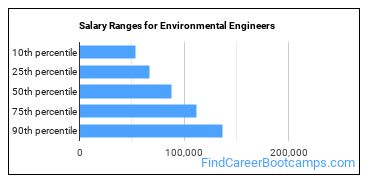
Environmental Engineers who work in Alaska, Louisiana, or California, make the highest salaries.
Below is a list of the median annual salaries for Environmental Engineers in different U.S. states.
| State | Annual Mean Salary |
|---|---|
| Alabama | $82,020 |
| Alaska | $116,680 |
| Arizona | $80,330 |
| Arkansas | $89,540 |
| California | $105,480 |
| Colorado | $98,350 |
| Connecticut | $88,810 |
| Delaware | $84,480 |
| District of Columbia | $100,060 |
| Florida | $80,540 |
| Georgia | $79,700 |
| Hawaii | $91,270 |
| Idaho | $96,870 |
| Illinois | $92,200 |
| Indiana | $82,180 |
| Iowa | $79,210 |
| Kansas | $85,400 |
| Kentucky | $80,900 |
| Louisiana | $108,980 |
| Maine | $75,440 |
| Maryland | $102,650 |
| Massachusetts | $90,070 |
| Michigan | $93,770 |
| Mississippi | $72,400 |
| Missouri | $72,290 |
| Montana | $84,960 |
| Nebraska | $90,320 |
| Nevada | $92,810 |
| New Hampshire | $99,840 |
| New Jersey | $88,360 |
| New Mexico | $95,720 |
| New York | $90,470 |
| North Carolina | $82,110 |
| North Dakota | $76,770 |
| Ohio | $85,970 |
| Oklahoma | $79,590 |
| Oregon | $97,440 |
| Pennsylvania | $89,410 |
| Rhode Island | $91,940 |
| South Carolina | $76,970 |
| South Dakota | $99,760 |
| Tennessee | $93,620 |
| Texas | $102,660 |
| Utah | $76,530 |
| Vermont | $82,430 |
| Virginia | $86,330 |
| Washington | $99,750 |
| West Virginia | $69,800 |
| Wisconsin | $81,860 |
| Wyoming | $93,680 |
Tools & Technologies Used by Environmental Engineers
Although they’re not necessarily needed for all jobs, the following technologies are used by many Environmental Engineers:
- Microsoft Excel
- Microsoft Word
- Microsoft Office
- Microsoft PowerPoint
- Python
- Microsoft Access
- Microsoft Project
- Autodesk AutoCAD
- The MathWorks MATLAB
- SAS
- Computer aided design CAD software
- Bentley Microstation
- ESRI ArcView
- Autodesk AutoCAD Civil 3D
- Formula translation/translator FORTRAN
- Computer aided design and drafting software CADD
- Insightful S-PLUS
- Geomechanical design analysis GDA software
- Maplesoft Maple
- Simulation software
How to Become an Environmental Engineer
Individuals working as an Environmental Engineer have obtained the following education levels:

How many years of work experience do I need?
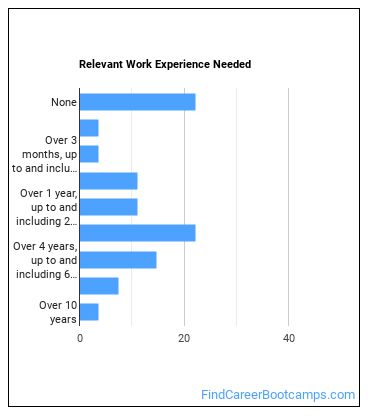
Where Environmental Engineers Are Employed
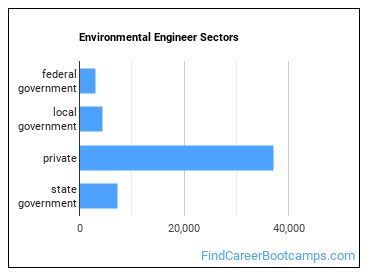
The table below shows some of the most common industries where those employed in this career field work.
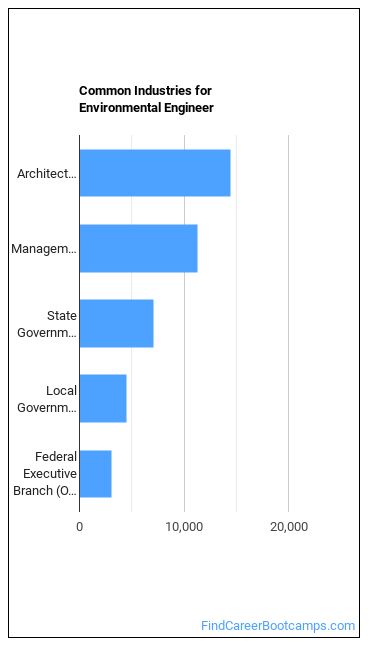
Similar Careers
Those thinking about becoming an Environmental Engineer might also be interested in the following careers:
- Landscape Architects
- Mining and Geological Engineers, Including Mining Safety Engineers
- Geoscientists, Except Hydrologists and Geographers
- Mechanical Engineers
- Marine Architects
- Materials Scientists
- Nuclear Engineers
- Petroleum Engineers
- Marine Engineers
Are you already one of the many Environmental Engineer in the United States? If you’re thinking about changing careers, these fields are worth exploring:
References:
Image Credit: U.S. Air Force photo by Staff Sgt. Alesia Goosic via Public Domain
More about our data sources and methodologies.
